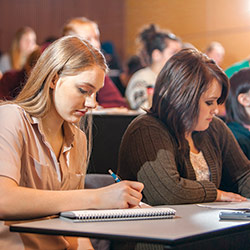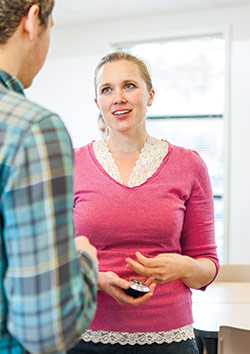
By Cara Wall-Scheffler, Associate Professor of Biology | Photos by Luke Rutan
In 1935, the celebrated Christian author Dorothy Sayers wrote an homage to her beloved Oxford University entitled Gaudy Night. Sayers had been a student at Oxford during a period when women were not valued contributors to university life, only being granted the right to a degree in October 1920. Sayers completed her course work in 1915, and became one of the first women to receive her degree. She uses much of Gaudy Night to interact with this struggle, asking exactly the same question we are asking today — what is the value of a university education?
What is the use of person-to-person discussions between faculty and students? What is the gain for a person, as well as the social group and culture generally? And for Sayers in particular, what is it about a university education that is worth the struggle to attain it when it has been repeatedly denied you?
In my own work as a faculty member, I have never doubted the value of face-to-face interactions between faculty members and students, which are at the heart of a Seattle Pacific University education. I see this value essentially in two integrated categories: students’ learning and their developing personhood.
In any given class, students will be learning multiple types of information and skills, for instance, vocabulary (e.g., mitosis is cell division), comprehension (e.g., mitosis allows reproduction, healing, and growth), and critical thinking (e.g., why cells in one environment are going through mitosis, when other cells elsewhere are not). Whereas some definitions can be learned through mastery and memorization techniques, critical thinking often requires deeper interaction with the material, problem-solving, and connection with meaningful experiences.

In a classroom situation I can see the faces of my students, hear their questions, and more importantly, I can perceive in real-time their version of what I have just said (and written on the board). Also, the community of students working together gives a dynamic, interactive component to learning that allows me to know immediately when understanding is incomplete or confusion has resulted; I also know that suggesting students verbalize their questions, although important for engagement, is not the way to assess their learning. It is their responses to my questions, and the questions of their fellow students, that allow them — and me — to really know where they are in the stages of learning: mastery, comprehension, or application. The sooner I am able to ask and listen, the sooner we can decide if a new strategy for learning the material is necessary.
In my department, biology, we also engage students in the complex process of learning through research. We do not necessarily have “set” labs with a protocol to follow and known outcomes. Instead we set forth a problem — a real problem for which science might not have an answer. How will they solve it? What will they control? What will they vary? And then, what did they find?
The students must put whatever results they do have into context — the context of the discipline, vocabulary, and learning that they have attained as they studied their problem. They thus also engage in the dynamism of science and learning: How did all those “facts” get into the textbook anyway? What does it take for us to really know something? Why is science about consensus and interacting with others? How do they interpret what they read in the news and online?
Our students often go on to present their class work at conferences around the country, and to interact with senior scholars in a variety of disciplines and guilds. They travel, meet other scientists, and become proud of their problem-solving ability as well as the contributions they have made to a field. For many of our students, this type of learning experience gives them the ability to go on to teach overseas, to succeed in graduate school, or to serve wherever they’re needed — one of my students ended up running an ad-hoc hospital in the Dominican Republic following the Haitian earthquake.
But I think there is another, even more important, aspect of my work at SPU, and that is to work with students on a very personal level as they develop their worldviews. Some students seek me out for mentorship because I am a woman, others because I engage students in thinking about their own bodies and physiology, and still others because I teach our courses in evolution.
Additionally, I supervise many undergraduate researchers, and as they train their minds to work through research problems, they inevitably begin asking other intelligent and important questions. For instance: Are there differences between natural evil and moral evil? And (how) can evolutionary mechanisms be the way God creates?
These discussions often happen outside the classroom, and can take the form of late night email exchanges about vocation and calling (Friday night is apparently an introspective time for students). One such exchange culminated in the following few sentences: “It is now up to me to step up and choose to bury myself in honoring God with my work. Thank you for continuing to support and challenge me; it really means a lot.”
We also engage big questions together on trips to the Faraday Institute Course on Science and Religion, held annually in Cambridge, England, where our students engage with other students and scholars from around the entire world in conversations about faith and science: topics ranging from “Does evolutionary theory undermine religious belief?” to “What is a person?”
During the seven days we are in Cambridge, senior scholars lead 90-minute lecture-and-question periods about the moral, ethical, and spiritual issues that exist for faithful people who care about God’s creation. These events are followed by open forums, tours of Cambridge, and hours of discussions. Students consistently disclose to me, “I thought I was the only one asking these questions and thinking about these issues!”

I have always been proud of SPU students engaged in these conversations: They always ask questions, they sit for meals with the scholar who has just presented, and they earnestly seek to understand how the world works. I have been told on every visit that I bring the best students, and that SPU must be quite a place to foster such people, and I do have to agree.
Student responses to all of these interactions really just begin with, “I’m so grateful that it’s ok to ask questions” followed generally by “Thank you for taking time to work this out with me.” A university education, particularly the type of education we carry out at SPU, can carry forward into post-classroom life. We offer new, difficult ideas and we suggest possibilities of new worldviews.
My colleague, and my own mentor when I was an undergraduate, Professor of Sociology Kevin Neuhouser calls this the hatching of the good eggs — the students who come to us “good” but who must grow into adult birds (i.e., people). I have seen some educators just crack the eggs and hope the chicks will pick up the pieces. Instead, I understand that my job as a professor is to offer the interactions, the communications, and the friendships that keep our students from sitting in their cracked shells, and instead allows them to leave as competent, alert, complex thinkers. My hope is they will leave Seattle Pacific with a toolbox of knowledge, ideas, and hope to keep them learning and ably assessing new concepts their whole lives.
Cara Wall-Scheffler is associate professor of biology at SPU. Her work on human locomotion is widely cited, and she is one of the world’s leading scholars on the study of female gait, and in the factors that influence energy balance during walking. Wall-Scheffler was named Professor of the Year in 2012 by the students of SPU.
